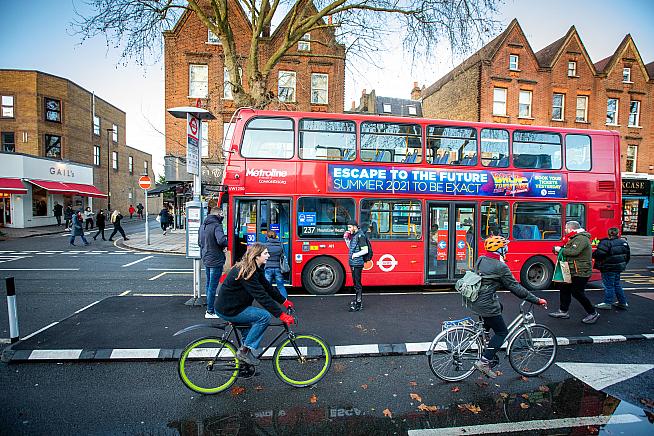New cycle count data from Transport for London (TfL) suggests that cycling increased in both inner and outer London last year, with the greatest increases in outer London.
Transport for London (TfL) has published new data that shows increased levels of cycling in both inner and outer London last autumn, as people across the capital continued to use active travel as a vital way of getting around during the coronavirus pandemic.
Despite a huge drop in the number of journeys being made overall as more people work from home and people only travel for legally permitted reasons, Londoners have been increasingly cycling to make essential trips and for exercise.

Since 2015, TfL has carried out annual cycle counts in both inner and outer London, usually in the spring. These count the numbers of people cycling past fixed points on the capital's cycling network over the course of a day.
Due to the coronavirus pandemic, cycle counts in 2020 were instead carried out in the autumn, with results showing a seven per cent increase in cycling in inner London and a 22 per cent increase in outer London, compared to the previous count in spring 2019.
Significant increases in outer London also suggest that the types of journeys may be changing, as people increasingly use bikes to get around their local area, to access their local high streets and for exercise.
TfL research shows people who walk, cycle or use public transport to visit their local high street do so more frequently, and spend up to 40 per cent more than those who travel by car. The number of people counted cycling on High Road Wembley increased by 236 per cent between spring 2019 and autumn 2020, with increases of 90 per cent on High Road Leyton and 61 per cent on Heath Road in Twickenham.
TfL data has also regularly shown significant increases in cycling at weekends, with an increase of 85 per cent over the weekend of 16-17 January 2021 - the most recent weekend for which TfL has data for.
These increases further highlight how important walking and cycling have been to supporting travel around London during the coronavirus pandemic. In December, TfL published its Travel in London report, which showed that almost half of all journeys between April and June 2020 were made by walking and cycling - up from 29 per cent before the pandemic.
Will Norman, London's Walking & Cycling Commissioner, said: "This new data highlights again how, against a backdrop of significantly less journeys being made overall, cycling has been a vital means of transport for Londoners during the pandemic, with a particularly significant increase in outer London as people turn to active travel to get around their local area and for exercise.
"It's therefore crucial that we ensure roads are safe for cyclists, and we continue to work with the boroughs to deliver new or upgraded protected cycle routes across the capital, to enable people to cycle safely and easily."
Alex Williams, TfL's Director of City Planning, said: "The coronavirus pandemic has had a huge impact on how people travel around the capital. This new data is further evidence of the vital role played by cycling during the pandemic and shows how important it is to make sure that there is space for Londoners to cycle safely, which is exactly why we've worked closely with the boroughs to deliver new protected cycle routes across the capital."
Santander Cycles membership hits record high
Figures released by TfL earlier this month show that its Santander Cycles scheme has provided a lifeline to tens of thousands of Londoners by enabling them to safely make essential journeys during the coronavirus pandemic.
New 24-hour Santander Cycles membership registrations rose by 167 per cent in the year to December 2020, representing the largest increase in the scheme's 10-year history. Meanwhile, registrations for new annual memberships increased by a quarter.
TfL continues to work with the boroughs to deliver new or upgraded protected cycle routes across London, with many of these delivered in outer London, including in Enfield, Greenwich, Hounslow and Kingston. Upgrades to the CS7 cycle route have given communities between Colliers Wood and Clapham access to a much improved, largely segregated route for cycling, while similar upgrades have also been carried out on the CS8 route between Lambeth Bridge and Chelsea Bridge.
Over the past year, TfL has also completed the first section of Cycleway 4 between central London and Rotherhithe and delivered a temporary section of the segregated Cycleway 9 route in Chiswick. Work continues to extend the Cycleway 4 route between Greenwich and Woolwich and a section of this was completed in December. This includes a much safer route through what TfL describe as "the dangerous and intimidating" Angerstein roundabout.
Waltham Forest, which has continued to deliver new high-quality routes over the past year with TfL funding, has carried out its own monitoring of its cycle network and saw journeys in December 2020 double compared to December 2019.
0 Comments





